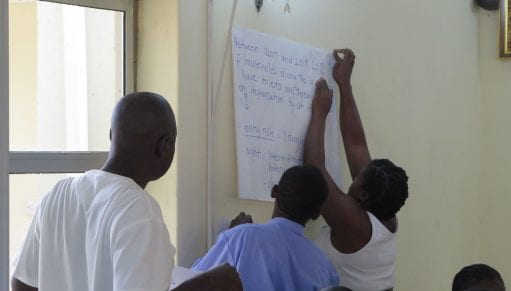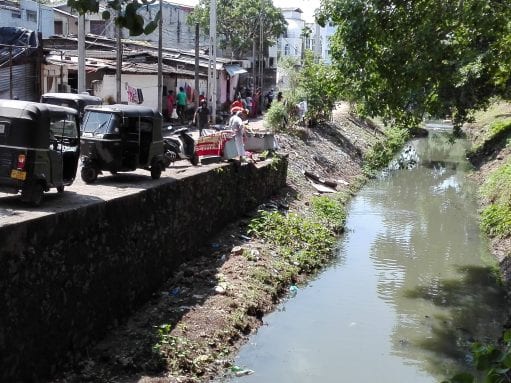How and in what ways can local-level risk information about health and disasters influence city government practices and policies?
By Cassidy A Johnson, on 28 February 2019
This blog is the fourth of the health in urban development blog series. View also:
Treat, contain, repeat: key links between water supply, sanitation and urban health
By Pascale Hofmann
Health in secondary urban centres: Insights from Karonga, Malawi
By Don Brown
Gaza: Cage Politics, Violence and Health
By Haim Yacobi
If you are interested in DPU’s new MSc in Health in Urban Development, more information can be found on our website.
Over the last few years there have been several initiatives to develop practical and policy-relevant ways to measure environmental risks faced by low-income groups. This has been in response to a severe lack of information about disaster and health risks available for policy makers to draw on in most low- and middle-income nations. There is a need for both detailed settlement-level data, particularly for informal settlements, as well as for aggregated data needed to inform city-level or national interventions[i]. In this blog, I discuss innovative methodologies that are being developed in cities of the Global South to generate much needed data for action.
Innovative methodologies for understanding health and disaster risks at the urban scale
Innovative methods developed for understanding and measuring these risks range from profiling and mapping informal settlements with community-led or co-production approaches, to detailed analysis of hospital, police and newspaper records. Other methods seek to build consensus based on perceptions and experiences of risk with communities and local governments. DesInventar is a collection of national, regional and city-level databases, which use newspaper reports, as well as police, hospital and accident records to create a detailed portrait of both large or intensive disasters and small-scale extensive disaster events. Other methodologies such as Slum/Shack Dwellers International (SDI) settlement profiling and Action at the Frontline use community-generated information about resident’s experiences of health and disaster risks in order to enter into dialogue with municipal governments about their needs. ReMapRisk uses community-generated risk information and offers a spatial analysis with maps to interrogate and visualise the information, there are maps for Lima (Peru), Karonga (Malawi) and Freetown (Sierra Leone). Other approaches, such CityRAP, The City Resilience Index and 10 Essentials for Making Cities Resilient focus on the municipal government’s perspectives of risks and capacities for addressing risk at the city-level, and often in dialogue with communities.
Health and disaster risks faced by the urban poor
These studies have found that women, men and children living in informal settlements are disproportionally exposed to small and large-scale disaster risks such as flooding, landslides and fires, as well as everyday risks, such as water borne illnesses and poor air quality. For example, the AXA-funded research I have been involved in in Dar es Salaam in Tanzania, used Action at the Frontline methodology, with household surveys, focus groups and action planning Mtambani settlement in Ilala municipality and Bonde la Mpunga settlement in Kinondoni municipality[ii]. The communities identified crime, poor solid management, lack of storm-water drainage infrastructure, lack of wastewater and toilet infrastructure, lack of basic health services and hospitals, flooding, high living costs and drug abuse as the main issues in their settlements. Many of these are directly related to health problems, such as malaria, diarrheal disease and personal safety. While big disasters, such a major floods, earthquakes, tsunami and windstorms do affect the health and welfare of millions across the globe every year, it is actually the smaller events and everyday risks that impact the greatest number of people’s health and well-being.
These different methods of understanding risks have been employed in close partnerships between researchers, community organisations, municipal authorities and other research users in many cities across Asia, Africa and Latin America. While there are many innovative initiatives for understanding and measuring risks, the data still remains extremely patchy and limited in scope. Furthermore, and its uptake into municipal government operations and planning is not guaranteed.
Principles for the uptake of risk information in urban planning and policy making
Through the Urban Africa Risk Knowledge programme[iii], researchers have identified some principles related to the uptake of local-level risk information into planning and policy making: 1) It is important not just to provide the type of information that are assumed to be useful, but to work closely with partners in identifying data that will be useful for policy and practice[iv]. 2) The community-driven process can be more conducive to driving change in practice and policy in local government than expert-driven data. The use of local knowledge that comes through communities collaborating with local level decision-makers can capture the qualitative experiences of risks and measure the burdens arising from these risks, while enabling communities to engage with local governments/state about their needs[v]. 3) Small steps at collecting local data that are ‘good-enough’ can be valuable in the beginning.[vi] 4) Project-based risk measurement initiatives are rarely enough to make a difference in government practices and policies. What is required is long-term and sustained engagement with information that is regularly updated. 5) Improving official data collection, such as census, vital registration systems and healthcare records will be necessary to systematically address disaster and health risks in informal settlements[vii].
Many cities in low- and middle- income countries, and especially in sub-Saharan Africa, do not have functioning local governments, they lack a metropolitan structure or their resources are too meagre to take on new initiatives. While some progress has been made in developing methodologies that help us to better understand the everyday and small-scale disaster risks that underpin women’s, men’s and children’s health in informal settlement, there is still much more to do to scale up these initiatives and to enable local governments to take actions to address risks.
References
[i] Satterthwaite, D and Sverdlik, A (2018). Assessing health risks in informal settlements in sub-Saharan African cities. Urban Africa Risk Knowledge Briefing, No. 10. June 2018. Available from: https://www.urbanark.org/assessing-health-risks-informal-settlements-sub-saharan-african-cities
[ii] Osuteye, E. at al. (2018). Communicating risk from the frontline: projecting community voices into disaster risk management policies across scales. Urban Africa Risk Knowledge Briefing, No. 19. October 2018. Available from:
[iv] Dodman, D., Leck, H. and F. Taylor (2017). Applying multiple methods to understand and address urban risk. Urban Africa Risk Knowledge Briefing, No. 7. July 2017. Available from: https://www.urbanark.org/applying-multiple-methods-understand-and-address-urban-risk
[v] Osuteye, E. at al. (2018). Communicating risk from the frontline: projecting community voices into disaster risk management policies across scales. Urban Africa Risk Knowledge Briefing, No. 19. October 2018. Available from: https://www.urbanark.org/communicating-risk-frontline-projecting-community-voices-disaster-risk-management-policies-across
[vi] Spaliviero, M. at al. (2019). Urban Resilience building in fast-growing African Cities. Urban Africa Risk Knowledge Briefing, No. 20, January 2019. Available from: https://www.urbanark.org/urban-resilience-building-fast-growing-african-cities
[vii][vii] Adelekan, I.O. and D. Satterthwaite (2019). Filling the data gaps on everyday and disaster risks in cities: The case of Ibadan. Urban Africa Risk Knowledge Briefing, No 22. January 2019. Available from: https://www.urbanark.org/filling-data-gaps-every-day-and-disaster-risks-cities-case-ibadan
 Close
Close













